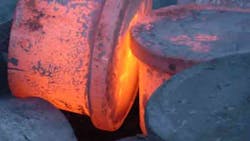Forging metal products is a big business, of course, but it’s also a personal effort, possibly more personal for the hundreds of men and women involved in the industry because of the specific nature of the work they do, the insights and experiences they apply to their work, and efforts they make to promote success. As the year draws to a close, it’s important to note that the success of the forging industry, or of any forging organization, also counts as success for individuals.
This is the first of a series examining FORGING’s 2015 Business Outlook survey.
Read part 2: "Review, Evaluating, and Setting Expectations"
That is reason that we conduct the annual FORGING Business Outlook survey. Each year, during September and October, we survey readers to measure the outlook of men and women responsible North America’s forging operations. We seek to identify the problems they face in the economy, in their markets, and in their businesses. We also seek to learn what plans they're making for the coming business cycle, and to understand better they're expectations for the year ahead.
We surveyed readers by email over a period of six weeks, with a detailed study that focuses on the forging business, its risks and prospects, and the internal and external factors shaping it. Their perspective is valuable not only because of their insights and advantages, but because they occupy positions that are critical (perhaps essential) to the prospects of so many other elements of the global industrial economy.
But let us start with the wider view: As 2015 approaches, there is some basis for optimism in the manufacturing economy. The first frame of reference on manufacturing is the Institute for Supply Management’s Purchasing Managers’ Index — a monthly survey of 400 purchasing managers that tracks production levels, volumes of new orders, rates of supplier deliveries, inventories, and employment levels in 18 specific manufacturing industries (many of which are significant consumers of forged products.)
In all but one index (prices), the purchasing managers’ consensus is that manufacturing is expanding, the 18th consecutive month for that result, and overall U.S. economic expansion has now entered its 66th straight month.
PMI is the wide-angle view, but more important is that is a measure of recent activity: as a forecast of future developments its value is mainly to boost confidence — not unimportant, but difficult to quantify.
A contrary view of current manufacturing conditions may be found in the Census Bureau’s Advance Report on Durable Goods Manufacturing, which has posted two consecutive months of slower results. There are other unsettling industrial trends too (steel prices, metal service center deliveries, machine tool orders) that suggest manufacturers are uncertain about near-term demand.
Larry Korak, director of Industry & Strategy for Infor’s Industrial Manufacturing business (a developer of enterprise software platforms), accepted the challenge: “Although durable goods orders declined in the most recent two months, we anticipate growth of between 2% and 3% in 2015,” he said, citing a series of countervailing factors. These include a housing sector that has grown “gradually and steadily since 2012”; slow growth in manufacturing wages (“the amount of money companies can spend on infrastructure”); and continued availability of affordable natural gas, which reduces manufacturers’ operating and material costs (i.e., plastics and resins.)
Korak also sees positive signs for U.S. manufacturers’ position in the global economy. “The Trade Weighted Index is anticipated to rise slightly in the coming year,” he reported, “which indicates that the dollar is strengthening relative to the currencies of other major trading partners. When the value of the dollar increases, imports to the U.S. become less expensive while exports to other countries become more expensive. This slight change typically favors importers. However, consolidation and globalization within durable goods manufacturing should tend to offset this impact.”
He also pointed to a World Bank forecasts for slight reductions in world commodity prices throughout 2015, suggesting manufacturing customers will be able to extend their purchasing without concern for inflation.
The Infor strategist sees these factors as generally beneficial to durable goods manufacturers, regardless of their particular production programs. “We anticipate slight growth across all sectors,” Korak offered. “The largest concern we see is in the availability of skilled labor within rural areas, which is constraining growth. Small producers and fabricators are particularly at risk given their inability to compete for resources, (and) this trend is not sector specific.”
What does the survey data tell us about forgers' 2014 results, and 2015 expectations? Read part 2 of the 2015 Business Outlook: "Review, Evaluating, and Setting Expectations"
About the Author
Robert Brooks
Editor/Content Director - Endeavor Business Media
Robert Brooks has been a business-to-business reporter, writer, editor, and columnist for more than 20 years, specializing in the primary metal and basic manufacturing industries. His work has covered a wide range of topics including process technology, resource development, material selection, product design, workforce development, and industrial market strategies, among others.
Currently, he specializes in subjects related to metal component and product design, development, and manufacturing—including castings, forgings, machined parts, and fabrications.
Brooks is a graduate of Kenyon College (B.A. English, Political Science) and Emory University (M.A. English.)

